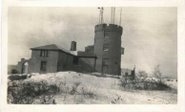Winter '11 / '12 - The North Atlantic Oscillation and Sea Surface Temperatures - Part 2
Hi-latitude blocking INVOF Greenland is known to be the main culprit for driving the North Atlantic Oscillation (NAO) index below zero. The negative state of the NAO is widely held in high regard as a crucial element for the development of severe winter storms in the eastern CONUS...despite strong evidence to the contrary that the Arctic Oscillation (AO) plays a much more important role.
Today's AO reached the 2nd highest value since record keeping began in 1950. The NAO can be thought of as the eastern extension of the AO. These two indexes often rise and fall in tandem but not always.
Medium and short range forecasting of the NAO is difficult...at best. The correlation between NWP model forecasts and observed conditions at ranges of 10 and 14 days are currently 0.596 and 0.447...respectively. The forecasts are able to explain 36% and 20% of the NAO's variability. There's barely any skill at 10 days and none at 14 days.
This predictive limitation often leads to the conclusion the NAO cannot be reliably forecast beyond about seven days at best. The current seven-day correlation coefficient of 0.720 which means NWP explains 52% of the indice's variability.
There may be a predictive a relationship between sea surface temperature anomalies (SSTA) in the northern Atlantic in December and the state of the NAO...as shown below.
- Positive areas on the map indicate a positive correlation between SSTA and the NAO state. When SSTAs are positive (negative)...then NAO is positive (negative).
- Negative values on the map indicate a negative correlation between SSTA and the NAO state. When SSTAs are negative (positive)...then NAO is positive (negative).
For example...if above (below) normal SSTAs are observed along the west coast of Greenland in the Baffin Bay they are correlated with a negative (positive) NAO state .
The map shown below depicts SSTAs...as of 01-DEC-11.
Note the above normal SSTAs along the lower SW and SE coasts of Greenland and the negative SSTAs NE of the Azores. The correlation is negative along the Greenland coast and a positive NE of the Azores. These anomalies suggest favorable conditions for a negative NAO state.
Also note the above normal SSTAs along the NE CONUS coastline. These anomalies suggest favorable conditions for a positive NAO state.
There/s no clear signal about the future state of the NAO given the current SSTA observations; however...warmer than normal waters along coastal Greenland could contribute to ridge building should the long wave flow regime shift from its current configuration.
---
An earlier post explored the predictive relationship discoved by the UK MET Office between SSTAs observed in May and the state of the NAO during the following winter.
Today's AO reached the 2nd highest value since record keeping began in 1950. The NAO can be thought of as the eastern extension of the AO. These two indexes often rise and fall in tandem but not always.
Medium and short range forecasting of the NAO is difficult...at best. The correlation between NWP model forecasts and observed conditions at ranges of 10 and 14 days are currently 0.596 and 0.447...respectively. The forecasts are able to explain 36% and 20% of the NAO's variability. There's barely any skill at 10 days and none at 14 days.
This predictive limitation often leads to the conclusion the NAO cannot be reliably forecast beyond about seven days at best. The current seven-day correlation coefficient of 0.720 which means NWP explains 52% of the indice's variability.
There may be a predictive a relationship between sea surface temperature anomalies (SSTA) in the northern Atlantic in December and the state of the NAO...as shown below.
- Positive areas on the map indicate a positive correlation between SSTA and the NAO state. When SSTAs are positive (negative)...then NAO is positive (negative).
- Negative values on the map indicate a negative correlation between SSTA and the NAO state. When SSTAs are negative (positive)...then NAO is positive (negative).
For example...if above (below) normal SSTAs are observed along the west coast of Greenland in the Baffin Bay they are correlated with a negative (positive) NAO state .
The map shown below depicts SSTAs...as of 01-DEC-11.
Note the above normal SSTAs along the lower SW and SE coasts of Greenland and the negative SSTAs NE of the Azores. The correlation is negative along the Greenland coast and a positive NE of the Azores. These anomalies suggest favorable conditions for a negative NAO state.
Also note the above normal SSTAs along the NE CONUS coastline. These anomalies suggest favorable conditions for a positive NAO state.
There/s no clear signal about the future state of the NAO given the current SSTA observations; however...warmer than normal waters along coastal Greenland could contribute to ridge building should the long wave flow regime shift from its current configuration.
---
An earlier post explored the predictive relationship discoved by the UK MET Office between SSTAs observed in May and the state of the NAO during the following winter.


























No comments:
Post a Comment